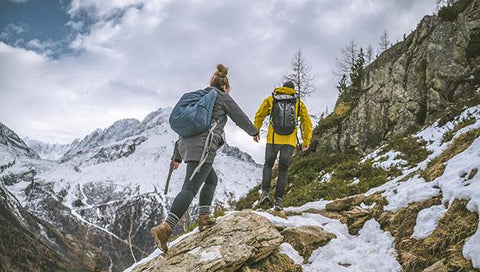Why do we say that how to stay warm while hiking in cold weather is an important lesson you should learn? Firstly, exposure to cold temperatures for extended periods can lead to hypothermia, a potentially dangerous condition where the body loses heat faster than it can produce it. Secondly, staying warm help prevent frostbite, a condition where the skin and underlying tissues freeze due to exposure to the cold weather.

Additionally, being cold and uncomfortable can affect your mood and energy levels, making the hike less enjoyable and potentially more dangerous if you become fatigued or disoriented.
Dressing While Hiking in Cold Weather
Dressing appropriately is one of the most important aspects on how to stay warm while hiking in cold weather. The layering system is a popular and effective method for dressing in cold weather, which involves wearing multiple layers of clothing that can be adjusted based on your level of exertion and temperature.The layering system typically includes three layers:

- Layering System
- Base Layer: This layer is in direct contact with your skin and should be made of a moisture-wicking fabric that helps move sweat away from your body. This layer should be lightweight and snug-fitting to prevent air from getting trapped between your skin and clothing.
- Insulating Layer: The middle layer provides insulation and helps trap heat close to your body. This layer can be made of materials such as fleece, down, or synthetic insulation. It should be loose enough to allow for movement but not too bulky that it restricts movement.
- Outer Layer: The outer layer, also known as the shell layer, provides protection from wind, rain, and snow. It should be made of a waterproof and breathable material that allows moisture to escape while keeping the elements out. A good outer layer should have adjustable features such as a hood, waist, and cuffs.
- Choosing the right fabrics
Choosing the right fabrics is crucial for staying warm and comfortable while hiking in cold weather. The ideal fabrics should be breathable, moisture-wicking, and provide insulation to keep you warm and dry.
Here are some popular fabric options for winter hiking:
- Wool: Wool is a natural fiber that provides excellent insulation and moisture-wicking properties. It's a great option for base layers and insulating layers, as it can retain warmth even when wet.
- Down: Down is a lightweight and compressible material that provides excellent insulation. It's commonly used in jackets, vests, and sleeping bags. Down is not a good option if you expect to encounter wet weather, as it loses its insulating properties when wet.
- Synthetic Insulation: Synthetic insulation is made of polyester fibers that mimic the properties of down. It's lightweight, compressible, and retains warmth even when wet. Synthetic insulation is a great option for jackets, vests, and sleeping bags.
- Fleece: Fleece is a synthetic material that provides excellent insulation and moisture-wicking properties. It's a great option for mid-layer clothing, as it's lightweight and breathable.
- Nylon and Polyester: Nylon and polyester are synthetic materials that are commonly used in outer shell layers. They're lightweight, breathable, and provide excellent protection from wind and water. Look for fabrics that are coated with a DWR (durable water repellent) finish to help shed water.

When choosing fabrics on how to stay warm while hiking in cold weather, consider the expected temperature, weather conditions, and your level of exertion. It's also important to choose fabrics that are easy to care for and maintain, as you'll likely be washing them frequently.
- Accessories
- Hat: A warm hat that covers your ears and forehead is essential for retaining body heat. Look for hats made of wool or synthetic materials with a fleece lining for added warmth.
- Gloves or mittens: Gloves or mittens are essential for protecting your hands from the cold. Mittens are generally warmer than gloves, as they allow your fingers to share heat. Look for gloves or mittens made of synthetic materials with a waterproof or water-resistant outer layer.
- Scarf or neck gaiter: A scarf or neck gaiter can help protect your neck and face from the cold wind. Look for materials that are breathable and moisture-wicking, such as wool or synthetic materials.
- Socks: Wearing the right socks is essential for keeping your feet warm and dry. Look for socks made of synthetic materials with moisture-wicking properties, and consider layering with a liner sock for added insulation.
- Boots: Choosing the right boots is critical for winter hiking. Look for boots with insulation, a waterproof or water-resistant outer layer, and a non-slip sole for traction on slippery surfaces. It's also important to choose boots that fit well and provide good ankle support.
Preparing for Winter Hiking Trip
Preparing for winter hiking is crucial for a safe and enjoyable experience. Here are some key steps to take before hitting the trail:
- A.Checking the weather forecast: Check the weather forecast for the area you'll be hiking in, paying attention to the temperature, wind, and chance of precipitation. Prepare for the worst-case scenario by bringing extra warm layers and waterproof gear.
- Planning the route and duration: Plan your route and the duration of your hike based on your level of experience and the conditions. Consider shorter routes or lower elevations in severe weather conditions.
- Informing someone of the hiking plans: Let someone know your hiking plans, including your expected route, duration, and expected return time. In the event of an emergency, this information can be crucial.
- Packing additional: Pack theseitemsyou may need, they would help you to keep warm, dry, and safe during your hiking trip.
- Map and compass: In the winter, trails may be covered in snow or difficult to see due to low light conditions. Therefore, it's important to pack a map and compass to help you navigate your way through the terrain. Make sure you know how to use them before heading out on your hike.
- First-aid kit: Accidents can happen, so it's essential to pack a first-aid kit. Include items such as bandages, gauze, antiseptic, and pain relief medication. Also, consider packing emergency supplies such as a whistle, a space blanket, and a signal mirror.
- Hand Warmer: If you’reconsidering purchasing a portable and functional hand warmer for hiking, Ocoopa would be a nice choice. Not only high-quality and long-lasting rechargeable hand warmers, some rechargeable hand warmers even come with additional features, like multiple temperature levels, and the ability as a power bank to charge your phone. Or if you’re planning to hike with friends, you can choose the Ocoopa UT They can be separated by two hands using or shared with others, then you two could stay warm and comfortable throughout the hiking trip.

- Food and water: In colder temperatures, your body uses more energy to keep warm, so it's essential to pack enough food and water to keep you hydrated and fueled throughout your hike. Consider packing high-energy snacks such as nuts, trail mix, and energy bars, as well as warm beverages such as tea or hot cocoa.
- Headlamp or flashlight: With fewer daylight hours in the winter, it's important to pack a headlamp or flashlight in case your hike takes longer than expected. Make sure to pack extra batteries as well.
During the Winter Hiking Trip
During winter hiking, it's important to take care of your body and protect yourself from the cold weather. Here are some tips for staying warm and comfortable during your hike:
- Staying hydrated and fueled: Drink plenty of water and bring high-energy snacks to maintain your energy levels throughout the hike. Dehydration can be a problem in cold weather, as your body may not feel as thirsty in the cold.
- Taking breaks: Take frequent breaks to rest, hydrate, and refuel. This will help prevent exhaustion and keep your body functioning optimally.
- Removing layers when necessary: If you start to feel too warm, remove layers to prevent overheating and sweating. Sweating can cause moisture buildup and make you feel colder when you stop moving.
- Avoiding hypothermia and frostbite: Know the signs of hypothermia and frostbite, and learn the symptoms of hypothermia and frostbite and seek help immediately if you or someone in your group exhibits any of these signs.
After the Winter Hiking Trip
- Changing into dry clothes: After completing a winter hike, it is important to change into dry clothes as soon as possible to prevent hypothermia and to stay comfortable. One should carry extra clothes to change into, including a warm, dry base layer, pants, socks, and a hat. Removing wet clothing and changing into dry clothes will help regulate body temperature and prevent chills.
- Replenishing fluids and nutrients: Winter hiking can be a physically demanding activity, and it is important to replenish fluids and nutrients after the hike. Drinking water or hot liquids, such as tea or soup, can help rehydrate the body. Consuming high-energy snacks or a nutritious meal can help replenish the body's glycogen stores and aid in muscle recovery.
- Cleaning and drying gear: Cleaning and drying gear after a winter hike is essential for its longevity and effectiveness. Gear should be inspected for any damages and cleaned thoroughly with mild soap and water. After cleaning, gear should be dried completely before storing to prevent mold and mildew.
- Reflecting on the hike and preparing for the next one: After the hike, take time to reflect on the experience and identify any areas for improvement. This could include reviewing the route taken, evaluating gear effectiveness, and considering training or conditioning for future hikes. Planning and preparing for the next hike should also be considered, including checking weather forecasts, selecting appropriate gear, and packing essential items.
Final Tips While Hiking in Cold Weather
Preparing for a winter hiking requires a bit of extra effort, but it's well worth it. With full preparation and knowledge, even hiking in cold weather can be a safe and enjoyable activity. By dressing appropriately, staying dry, staying hydrated and fueled, taking breaks, and staying aware of weather conditions, you would know how to stay warm while hiking in cold weather.
Also, bring with you suitable products to supply you with warmth and comfort, such as the Ocoopa rechargeable hand warmers, which could improve your winter hiking experience, helping you enjoy the beauty of winter hiking while staying safe and comfortable.
Lastly, do remember to always prioritize safety and be prepared for changing weather conditions, so then you can have a safe and comfortable winter hiking trip. Let’s go hiking do not let the weather deter you from exploring the beauty of nature!
